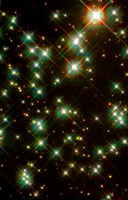 |

First Announcement The region of the Main Sequence centred on A stars, occasionally referred to as the "tepid" stars, represents an ideal laboratory to study a wide variety of physical processes that are at work to a greater or lesser extent in most stellar types. These processes include radiation driven diffusion, differential gravitational settling, grain accretion, convection, magnetic fields and non-radial pulsations. While their observable manifestation is particularly prominent in tepid stars, some or all of them do play a significant role in the physics, formation and evolution of stars of most types. Their understanding is becoming increasingly important for the refinement of stellar evolution models and for the improved treatment of the stellar contribution in studies of galactic evolution. IAU Symposium No. 224, entitled The A-star Puzzle, which took place in 2004, was dedicated to the detailed discussion of these processes. Further progress can now be achieved by considering the A stars into the broader contexts of stellar evolution and galactic environment. Many works that have been carried out in the past decade open this new perspective.
While for more than 50 years, Ap stars were the only early-type stars in which the widespread presence of magnetic fields had been definitely confirmed, such fields have now been detected in several types of hotter stars (Slowly Pulsating B stars, Îќ Cephei stars, O-type stars) as well as in other A stars such as Vega and Sirius. These discoveries were made possible by the advent of a new generation of spectropolarimeters, allowing stellar magnetic fields to be measured with unprecedented accuracy (ESPaDOnS at the Canada-France-Hawaii Telescope since 2005, NARVAL at Pic-du-Midi Observatory since 2006, and HARPSpol at ESO since 2009), as well as by the development of new diagnostic techniques particularly adapted to the study of early-type stars (such as the novel usage of the low-resolution spectropolarimetric mode of the ESO instrument FORS, introduced in 2004). Abundance inhomogeneities, which have long been known to exist on the surface of Ap stars, where they were thought to result from the combined effects of radiative diffusion and of the magnetic field, have since 2005 been unambiguously shown to be ubiquitous on HgMn stars, whose magnetic fields have so far remained elusive. The magnetic and abundance properties are different among the various groups of stars, and their comparison opens new prospects to understand their origin. The confirmed detection of magnetic fields in Herbig Ae-Be stars, which are likely progenitors of the Ap stars, and the identification of weakly magnetic giants as possible descendants of Ap stars, hold the potential to shed new light on the origin and evolution of magnetic fields in tepid stars. New theoretical developments suggesting late-stage mergers of protostars as a possible mechanism for the generation of strong, large-scale magnetic fields in A stars, open new prospects and prompt a careful reconsideration of binarity in the middle main sequence.
On-going systematic studies of magnetic fields of Ap stars in open clusters of a range of ages hold the promise of new constraints on the emergence of such fields and on their evolution during stellar main sequence lifetime. State-of-the-art abundance determinations in binary A stars in open clusters allow the age, mass and chemical composition to be derived with unprecedented accuracy.
This information can in turn be used to constrain evolutionary models, for which in the past decade, the prescriptions for hydrodynamical processes such as mass loss, turbulent diffusion, transport of angular momentum and chemical species by rotation, and gravity waves, have been considerably improved.
The occurrence of differential rotation in the convective cores of A stars is inferred from 3D simulations. Convective motions penetrate into the radiative envelope and small-amplitude circulations and gravity waves are excited within the radiative zones. Vigorous convection in the core can help building up strong magnetic fields through dynamo action and amplify a remnant primordial field by several orders of magnitudes and maintain them.
The first photometric detections of extragalactic Ap stars, strengthened by spectroscopic confirmation in 2011, open the door to investigations of processes such as radiative diffusion, gravitational settling and magnetic fields in environments of different metallicities. Significant advances in asteroseismology made possible by the space missions MOST, CoRoT and Kepler, which deliver data of exquisite photometric accuracy, shed a wholly new light on the pulsational properties of pre-main-sequence, main-sequence and post-main-sequence, superficially normal and chemically peculiar A stars. While for a long time, the number of frequencies that could be observed was vastly less than predicted by theory, this trend is now reversed. The boundaries of the "traditional" delta Sct and gamma Dor instability strips are being redefined, and a new group of hybrid pulsators, where the different excitation mechanisms of the former two classes act concurrently, is emerging as an important component of the tepid star seismic landscape.
With the fast-developing knowledge of the circumstellar environment of pre-main-sequence and main-sequence A stars, including protoplanetary disks, comet reservoirs and exoplanets, the relation between this environment, the early evolution of A stars, and the possible appearance of their magnetic fields and surface chemical anomalies, becomes open to investigation.
The conference will bring together A-star experts and specialists of the related fields sketched above, with a view to gaining new insight into the processes manifesting themselves in A stars by putting them in the broader context of their pre- and post-main sequence evolution, and of their physical environment. Conversely, the significance of A stars for stellar and galactic physics in general will also be discussed.

|
 |

